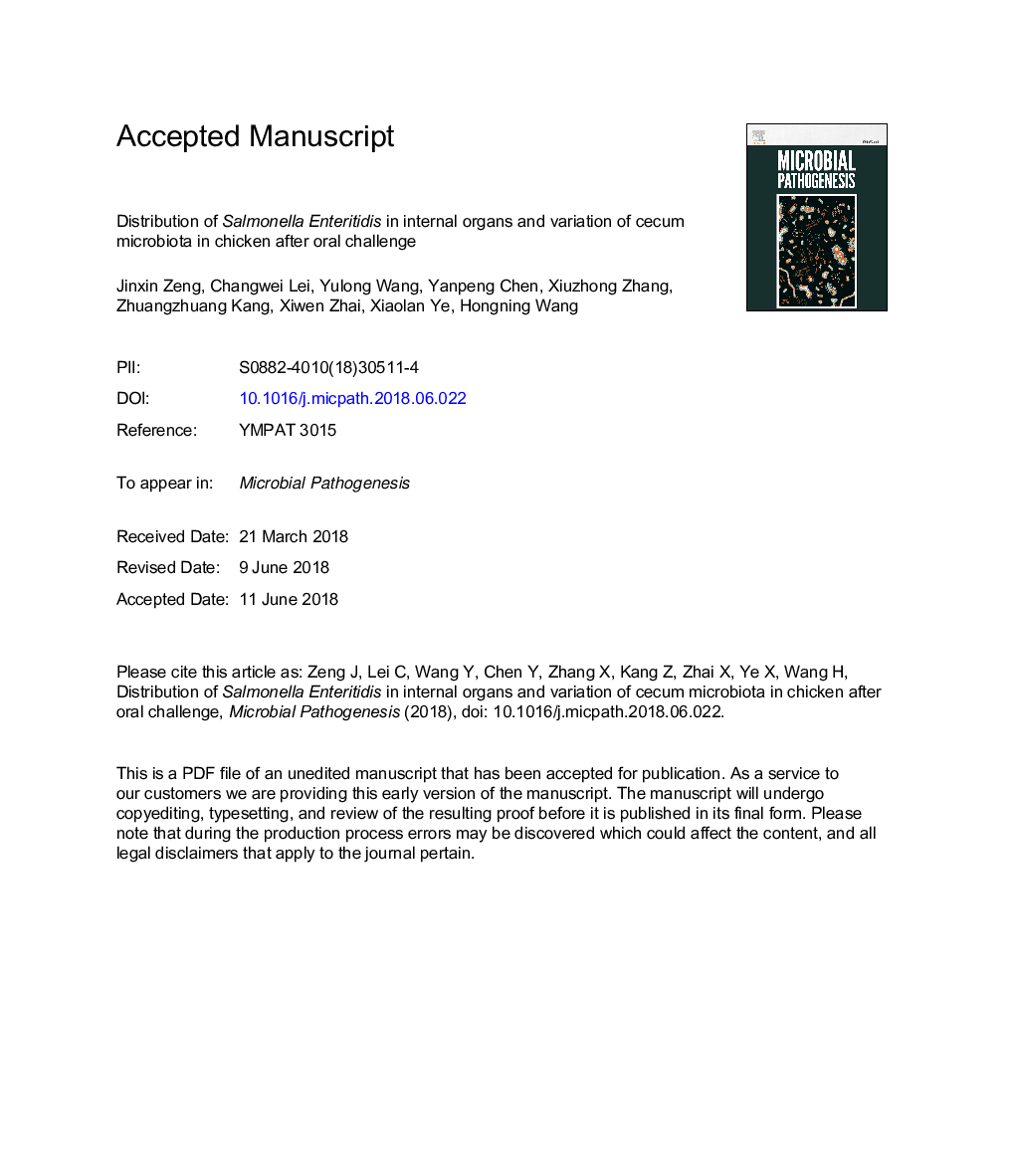| کد مقاله | کد نشریه | سال انتشار | مقاله انگلیسی | نسخه تمام متن |
|---|---|---|---|---|
| 8749309 | 1593667 | 2018 | 21 صفحه PDF | دانلود رایگان |
عنوان انگلیسی مقاله ISI
Distribution of Salmonella Enteritidis in internal organs and variation of cecum microbiota in chicken after oral challenge
دانلود مقاله + سفارش ترجمه
دانلود مقاله ISI انگلیسی
رایگان برای ایرانیان
موضوعات مرتبط
علوم زیستی و بیوفناوری
ایمنی شناسی و میکروب شناسی
میکروب شناسی
پیش نمایش صفحه اول مقاله

چکیده انگلیسی
The aim study was to explore the distribution of Salmonella Enteritidis (S. enteritidis) in internal organs and variation of cecum microbiota in newly hatched chicken after oral challenge during a 21-day period. The quantities of S. enteritidis DNA in different internal organs (heart, liver, spleen, stomach, pancreas, small intestine, blood and cecum contents) were determined by real-time fluorescent quantitative polymerase chain reaction (FQ-PCR). The result showed that all of the above-mentioned samples were positive at 12â¯h post inoculation (PI) after oral challenge. The highest copy numbers of S. enteritidis in all tissue were heart and liver, with about 2â¯Ãâ¯102 to 6â¯Ãâ¯106 copies of DNA target sequences/0.5â¯g. The copy number of S. enteritidis in the stomach was only lower than the heart and liver. The blood at 8â¯d PI, the pancreas at 10â¯d PI, the heart at 14â¯d PI and the stomach at 17â¯d PI didn't have a positive result. However, the liver, spleen, cecum contents and small intestine were all positive during the 21-day period. The cecum contents at 0â¯d PI, 4â¯d PI and 10â¯d PI from the control group and experiment group were collected for bacterial 16â¯S rRNA sequencing targeting the V3-V4 hypervariable region. The result showed that at the 0â¯d PI, the main cecum microbiota ingredient of the two-day old chicken was Enterobacteriaceae (Proteobacteria) and the other microbiology species were fewer. At the 10â¯d PI, the microbiota ingredient of cecum became abundant and stable mainly including the families Ruminococcaceae (Firmicutes), Enterobacteriaceae (Proteobacteria), Lachnospiraceae (Firmicutes) and clostridiacaea (Firmicutes) both of the two group, suggesting Salmonella infection with 2-day old chicken might not significantly change cecum microbiota community. The study indicated the major organs, which carried numerous S. enteritidis, providing a significantly guideline for salmonella detection in poultry and revealed the main microbiota ingredient of chicken cecum.
ناشر
Database: Elsevier - ScienceDirect (ساینس دایرکت)
Journal: Microbial Pathogenesis - Volume 122, September 2018, Pages 174-179
Journal: Microbial Pathogenesis - Volume 122, September 2018, Pages 174-179
نویسندگان
Jinxin Zeng, Changwei Lei, Yulong Wang, Yanpeng Chen, Xiuzhong Zhang, Zhuangzhuang Kang, Xiwen Zhai, Xiaolan Ye, Hongning Wang,